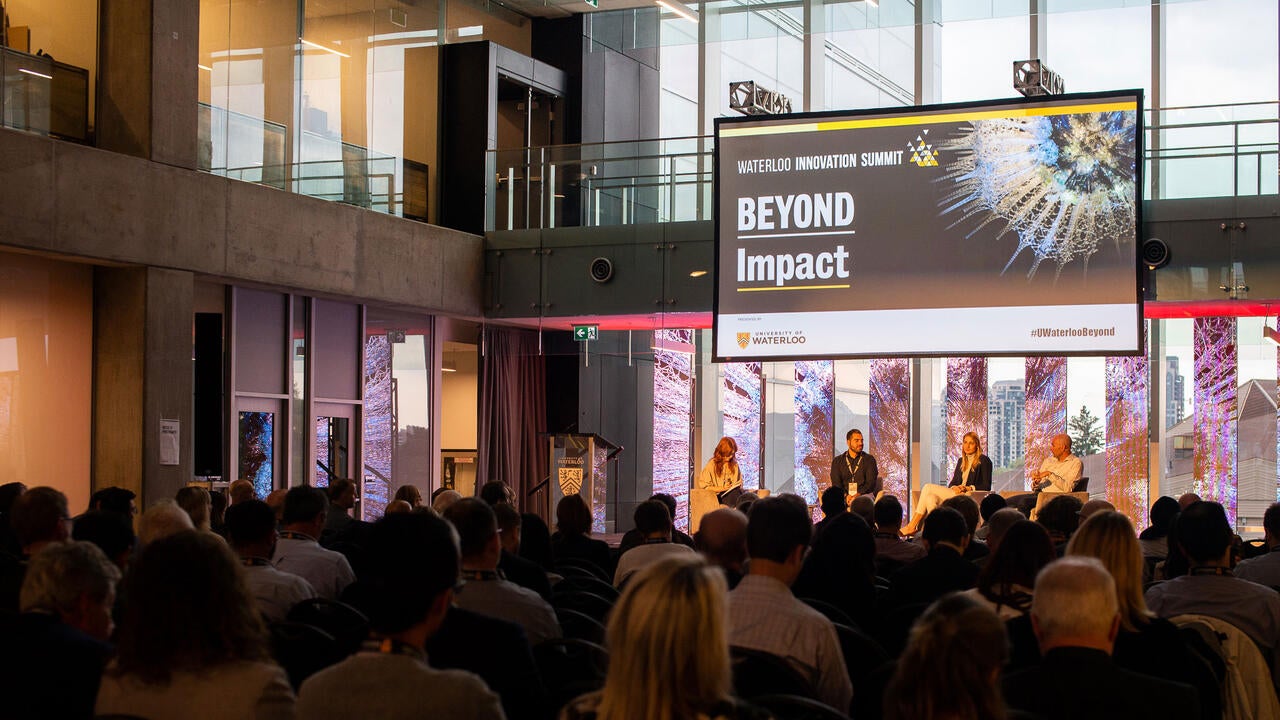
HealthTech leaders share what it takes to bring innovations to market
Waterloo Innovation Summit reimagines health with technology

Waterloo Innovation Summit reimagines health with technology
By Stephanie Longeway University RelationsLeaders in HealthTech today called for policymakers and health providers to urgently adapt to emerging technologies and respond to the fast innovation cycles of industry, researchers and entrepreneurs.
As technology continues to disrupt the delivery of global and individual health, scientists, entrepreneurs, medical professionals and policy experts told the audience at the Waterloo Innovation Summit that policy innovation needs to keep pace with the development of new technologies and advancements in processes that will enable practitioners to improve life-saving care.
Here are five ways to foster new pathways to bring technological innovations to market.
The journey from building a startup into a mature business is a complicated road. Many startups will sell their innovations to larger foreign companies, but Armen Bakirtzian, CEO and co-founder of Intellijoint Surgical, told the Summit audience his plan to help startups gain the skill needed to scale-up and thrive in Canada’s economy.
Bakirtzian has founded the Medical Innovation Xchange in Waterloo region to assist small HealthTech companies to grow their business in an environment where they can collaborate on the unique challenges they face trying to break into the industry.
Hear why Bakirtzian is investing in the Canadian HealthTech ecosystem
The founder of VeraMito, Chris Wormald, agrees with Bakirtzian and sees the health industry playing an important role in building a sustainable HealthTech ecosystem. He noted that Health Canada has made it relatively easy to enter the marketplace, but more can be done in the procurement process to prioritize Canadian companies. For example, Intellijoint has performed over 10,000 hip surgeries to-date, but only 50 have been done in Canada.
Wormald and Bakirtzian agree that we need to value Canadian-made innovation.
“We can build something here that is sustaining,” said Wormald. “There is a time for med-tech, the time is now and the place is here in Canada.”
Ronald Li (BSc ’94), CEO and founder, Novoheart Ltd., shared his 20-year journey of turning a breakthrough in bioengineering into real-world solutions. Li developed the world’s first miniature beating human hearts using human stem cells. His discovery is now poised to alter the future of drug design and delivery, but the business of bringing a product to market means he needs to make strategic decisions outside of his lab.
Hear how Li is finding strategic partners will allow Novoheart to develop their technology and get it ready for a mass market down the road.
Data-driven solutions have the potential to make care more efficient by reducing health care costs and assisting care workers.
Moazam Khan (BSc ’16, MBET ’17), CEO and co-founder of Curiato Inc., showcased how he uses data from his sensor-laden bedsheet to monitor patients for bedsores — a critical issue in North America costing seven lives every hour and up to $20B every year.
Data may also be the key to unlocking equity in our health care system. Panelist Bill Tatham (BASc ’83), founder of NexJ Health Inc., is improving the overall health of underserved populations and patient experience through his data-sharing platform. NexJ is providing a solution for virtual care enabling remote access to critical information for all care providers, linking the community, acute care, and rehabilitation centres to establish a shared care plan that patients and their families can contribute to.
It takes an ecosystem of stakeholders to infuse innovation into health systems, and it all begins with curiosity that spawns a transformational idea or breakthrough.
Donna Strickland, Nobel laureate in Physics 2018 and Waterloo professor, told the packed audience that innovation happens in all different kinds of ways, but consistently she sees that scientific discoveries that lead to innovation can happen decades before there is an application in health care, for example. Strickland explained the need for collaboration — that government, industry and academics need to work together with long-term vision.
Watch Strickland discuss how HealthTech innovation requires an investment in time.
Accurate and predictive computational models are being used today in hospitals for better patient outcomes.
Dr. James Drake, surgeon-in-chief at The Hospital for Sick Children (SickKids), has had a two-decade relationship with Waterloo mathematicians and engineers. His current partnership with Jochen Koenemann and Ricardo Fukasawa, both professors at Waterloo, uses algorithms to assist surgeons in planning and carrying out delicate skull surgeries.
He argued the advantage of an academic model for innovation — one that encourages groups of students to work together in a collaborative effort.
Watch Dr. Drake discuss how he forms teams of clinicians and engineers in his lab
Anita Layton, Waterloo professor and Canada 150 Research Chair in Mathematical Biology and Medicine, endorsed the importance of collaboration between disciplines. She feels universities, like Waterloo, can be leaders in fostering this integration and train the next generation of scientists to use algorithms and computational models to enhance medicine.
Watch Layton explain the need for specialists who understand both math and medicine

Read more
The very first computational human kidney model can help scientists better understand the effectiveness of the drugs we consume

Read more
How a new quantum sensor could improve cancer treatment

Read more
Waterloo students’ capstone design project nationally recognized for overcoming accessibility barriers
The University of Waterloo acknowledges that much of our work takes place on the traditional territory of the Neutral, Anishinaabeg, and Haudenosaunee peoples. Our main campus is situated on the Haldimand Tract, the land granted to the Six Nations that includes six miles on each side of the Grand River. Our active work toward reconciliation takes place across our campuses through research, learning, teaching, and community building, and is co-ordinated within the Office of Indigenous Relations.